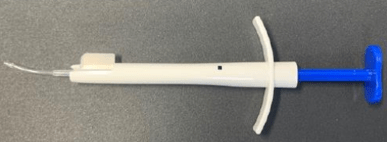Summary
Othman Guenoun
Business developer
Technology
- A device that allows soft tissue (agar plates, cell sheets) to be injected through a minimal subretinal incision.
- This instrument greatly reduces invasiveness and allows for maximum preservation of retinal structures.
- The implant is ‘loaded’ into a catheter using a first injector (winder), which then allows the implant to be injected subretinally.
- The device can also be used to implant flexible biological or artificial tissue into or under living organs. This flexible tissue contains cells capable of rebuilding cells in a diseased organ or prosthesis in order to restore its functionality, or any other substrate and content.
- This medical device consists of three parts:

1) A removable cartridge with a receptacle and a cannula designed to receive, package and guide the soft tissue. (Fig. 1)

2) A first pushing device for transferring the flexible tissue from the receptacle to the cannula when the injection cartridge is attached to this first pushing device. (Fig. 2)

3) A second pushing device adapted to transfer the flexible tissue from the cannula to the organ when the injection cartridge is attached to this second pushing device. (Fig. 3)
Market
- The ophthalmic treatment market is expected to reach $17.5 billion for retinitis pigmentosa by 2029 and $36 billion for AMD by 2032.
- Current subretinal implantation methods, which cause significant damage to the retina, combined with the increase in eye diseases, are creating strong demand for innovative surgical solutions.
Development
- In vitro (pig eyes) and in vivo (dogs and macaques) results for the implantation of a layer of retinal pigment epithelium
- Ergonomic testing in the laboratory
- Functional prototype
IP
- PCT Patent application filed
- September 2024 – PCT/IB2024/000546
Valorisation strategy
- Licensing
